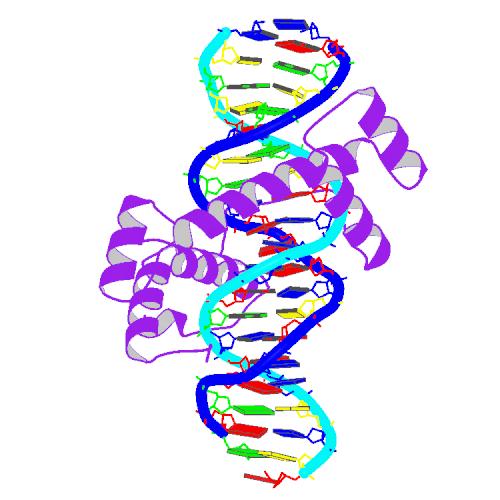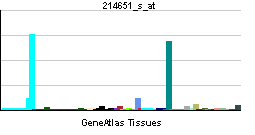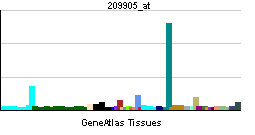HOXA9
| Homeobox A9 | |||||||||||||
|---|---|---|---|---|---|---|---|---|---|---|---|---|---|
 PDB rendering based on 1puf. | |||||||||||||
| |||||||||||||
| Identifiers | |||||||||||||
| Symbols | HOXA9 ; HOX1; ABD-B; HOX1.7; HOX1G; MGC1934 | ||||||||||||
| External IDs | Template:OMIM5 Template:MGI HomoloGene: 7766 | ||||||||||||
| |||||||||||||
| RNA expression pattern | |||||||||||||
 | |||||||||||||
 | |||||||||||||
| More reference expression data | |||||||||||||
| Orthologs | |||||||||||||
| Template:GNF Ortholog box | |||||||||||||
| Species | Human | Mouse | |||||||||||
| Entrez | n/a | n/a | |||||||||||
| Ensembl | n/a | n/a | |||||||||||
| UniProt | n/a | n/a | |||||||||||
| RefSeq (mRNA) | n/a | n/a | |||||||||||
| RefSeq (protein) | n/a | n/a | |||||||||||
| Location (UCSC) | n/a | n/a | |||||||||||
| PubMed search | n/a | n/a | |||||||||||
Homeobox A9, also known as HOXA9, is a human gene.
In vertebrates, the genes encoding the class of transcription factors called homeobox genes are found in clusters named A, B, C, and D on four separate chromosomes. Expression of these proteins is spatially and temporally regulated during embryonic development. This gene is part of the A cluster on chromosome 7 and encodes a DNA-binding transcription factor which may regulate gene expression, morphogenesis, and differentiation. This gene is highly similar to the abdominal-B (Abd-B) gene of Drosophila. A specific translocation event which causes a fusion between this gene and the NUP98 gene has been associated with myeloid leukemogenesis.[1]
See also
References
Further reading
- Scott MP (1992). "Vertebrate homeobox gene nomenclature". Cell. 71 (4): 551–3. PMID 1358459.
- McAlpine PJ, Shows TB (1990). "Nomenclature for human homeobox genes". Genomics. 7 (3): 460. PMID 1973146.
- Acampora D, D'Esposito M, Faiella A; et al. (1990). "The human HOX gene family". Nucleic Acids Res. 17 (24): 10385–402. PMID 2574852.
- Nakamura T, Largaespada DA, Lee MP; et al. (1996). "Fusion of the nucleoporin gene NUP98 to HOXA9 by the chromosome translocation t(7;11)(p15;p15) in human myeloid leukaemia". Nat. Genet. 12 (2): 154–8. doi:10.1038/ng0296-154. PMID 8563753.
- Borrow J, Shearman AM, Stanton VP; et al. (1996). "The t(7;11)(p15;p15) translocation in acute myeloid leukaemia fuses the genes for nucleoporin NUP98 and class I homeoprotein HOXA9". Nat. Genet. 12 (2): 159–67. doi:10.1038/ng0296-159. PMID 8563754.
- Apiou F, Flagiello D, Cillo C; et al. (1996). "Fine mapping of human HOX gene clusters". Cytogenet. Cell Genet. 73 (1–2): 114–5. PMID 8646877.
- Lawrence HJ, Helgason CD, Sauvageau G; et al. (1997). "Mice bearing a targeted interruption of the homeobox gene HOXA9 have defects in myeloid, erythroid, and lymphoid hematopoiesis". Blood. 89 (6): 1922–30. PMID 9058712.
- Kim MH, Chang HH, Shin C; et al. (1998). "Genomic structure and sequence analysis of human HOXA-9". DNA Cell Biol. 17 (5): 407–14. PMID 9628584.
- Izon DJ, Rozenfeld S, Fong ST; et al. (1998). "Loss of function of the homeobox gene Hoxa-9 perturbs early T-cell development and induces apoptosis in primitive thymocytes". Blood. 92 (2): 383–93. PMID 9657735.
- Patel CV, Sharangpani R, Bandyopadhyay S, DiCorleto PE (1999). "Endothelial cells express a novel, tumor necrosis factor-alpha-regulated variant of HOXA9". J. Biol. Chem. 274 (3): 1415–22. PMID 9880515.
- Shen WF, Rozenfeld S, Kwong A; et al. (1999). "HOXA9 forms triple complexes with PBX2 and MEIS1 in myeloid cells". Mol. Cell. Biol. 19 (4): 3051–61. PMID 10082572.
- Shi X, Bai S, Li L, Cao X (2001). "Hoxa-9 represses transforming growth factor-beta-induced osteopontin gene transcription". J. Biol. Chem. 276 (1): 850–5. doi:10.1074/jbc.M005955200. PMID 11042172.
- Hartley JL, Temple GF, Brasch MA (2001). "DNA cloning using in vitro site-specific recombination". Genome Res. 10 (11): 1788–95. PMID 11076863.
- Schaefer LK, Wang S, Schaefer TS (2001). "Functional interaction of Jun and homeodomain proteins". J. Biol. Chem. 276 (46): 43074–82. doi:10.1074/jbc.M102552200. PMID 11551904.
- Fujino T, Suzuki A, Ito Y; et al. (2002). "Single-translocation and double-chimeric transcripts: detection of NUP98-HOXA9 in myeloid leukemias with HOXA11 or HOXA13 breaks of the chromosomal translocation t(7;11)(p15;p15)". Blood. 99 (4): 1428–33. PMID 11830496.
- Kosaki K, Kosaki R, Suzuki T; et al. (2002). "Complete mutation analysis panel of the 39 human HOX genes". Teratology. 65 (2): 50–62. doi:10.1002/tera.10009. PMID 11857506.
- Calvo KR, Sykes DB, Pasillas MP, Kamps MP (2002). "Nup98-HoxA9 immortalizes myeloid progenitors, enforces expression of Hoxa9, Hoxa7 and Meis1, and alters cytokine-specific responses in a manner similar to that induced by retroviral co-expression of Hoxa9 and Meis1". Oncogene. 21 (27): 4247–56. doi:10.1038/sj.onc.1205516. PMID 12082612.
- Taketani T, Taki T, Ono R; et al. (2002). "The chromosome translocation t(7;11)(p15;p15) in acute myeloid leukemia results in fusion of the NUP98 gene with a HOXA cluster gene, HOXA13, but not HOXA9". Genes Chromosomes Cancer. 34 (4): 437–43. doi:10.1002/gcc.10077. PMID 12112533.
- Kawakami K, Miyanishi S, Nishii K; et al. (2002). "A case of acute myeloid leukemia with t(7;11)(p15;p15) mimicking myeloid crisis of chronic myelogenous leukemia". Int. J. Hematol. 76 (1): 80–3. PMID 12138901.
- Mayotte N, Roy DC, Yao J; et al. (2003). "Oncogenic interaction between BCR-ABL and NUP98-HOXA9 demonstrated by the use of an in vitro purging culture system". Blood. 100 (12): 4177–84. doi:10.1182/blood-2002-04-1244. PMID 12393433.
External links
- HOXA9+protein,+human at the US National Library of Medicine Medical Subject Headings (MeSH)
This article incorporates text from the United States National Library of Medicine, which is in the public domain.
| This article on a gene on human chromosome 7 is a stub. You can help Wikipedia by expanding it. |